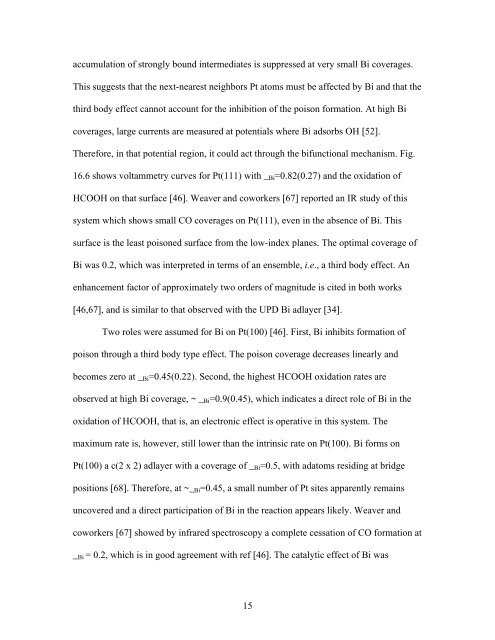electrocatalysis on surfaces modified... - Brookhaven National ...
electrocatalysis on surfaces modified... - Brookhaven National ...
electrocatalysis on surfaces modified... - Brookhaven National ...
You also want an ePaper? Increase the reach of your titles
YUMPU automatically turns print PDFs into web optimized ePapers that Google loves.
accumulati<strong>on</strong> of str<strong>on</strong>gly bound intermediates is suppressed at very small Bi coverages.<br />
This suggests that the next-nearest neighbors Pt atoms must be affected by Bi and that the<br />
third body effect cannot account for the inhibiti<strong>on</strong> of the pois<strong>on</strong> formati<strong>on</strong>. At high Bi<br />
coverages, large currents are measured at potentials where Bi adsorbs OH [52].<br />
Therefore, in that potential regi<strong>on</strong>, it could act through the bifuncti<strong>on</strong>al mechanism. Fig.<br />
16.6 shows voltammetry curves for Pt(111) with _ Bi =0.82(0.27) and the oxidati<strong>on</strong> of<br />
HCOOH <strong>on</strong> that surface [46]. Weaver and coworkers [67] reported an IR study of this<br />
system which shows small CO coverages <strong>on</strong> Pt(111), even in the absence of Bi. This<br />
surface is the least pois<strong>on</strong>ed surface from the low-index planes. The optimal coverage of<br />
Bi was 0.2, which was interpreted in terms of an ensemble, i.e., a third body effect. An<br />
enhancement factor of approximately two orders of magnitude is cited in both works<br />
[46,67], and is similar to that observed with the UPD Bi adlayer [34].<br />
Two roles were assumed for Bi <strong>on</strong> Pt(100) [46]. First, Bi inhibits formati<strong>on</strong> of<br />
pois<strong>on</strong> through a third body type effect. The pois<strong>on</strong> coverage decreases linearly and<br />
becomes zero at _ Bi =0.45(0.22). Sec<strong>on</strong>d, the highest HCOOH oxidati<strong>on</strong> rates are<br />
observed at high Bi coverage, ~ _ Bi =0.9(0.45), which indicates a direct role of Bi in the<br />
oxidati<strong>on</strong> of HCOOH, that is, an electr<strong>on</strong>ic effect is operative in this system. The<br />
maximum rate is, however, still lower than the intrinsic rate <strong>on</strong> Pt(100). Bi forms <strong>on</strong><br />
Pt(100) a c(2 x 2) adlayer with a coverage of _ Bi =0.5, with adatoms residing at bridge<br />
positi<strong>on</strong>s [68]. Therefore, at ~_ Bi =0.45, a small number of Pt sites apparently remains<br />
uncovered and a direct participati<strong>on</strong> of Bi in the reacti<strong>on</strong> appears likely. Weaver and<br />
coworkers [67] showed by infrared spectroscopy a complete cessati<strong>on</strong> of CO formati<strong>on</strong> at<br />
_ Bi = 0.2, which is in good agreement with ref [46]. The catalytic effect of Bi was<br />
15
















